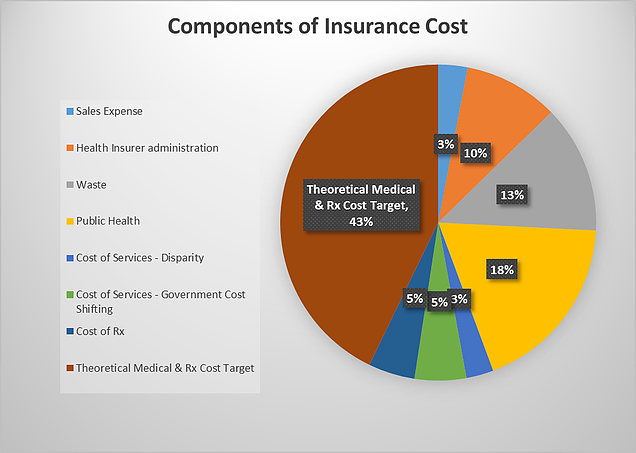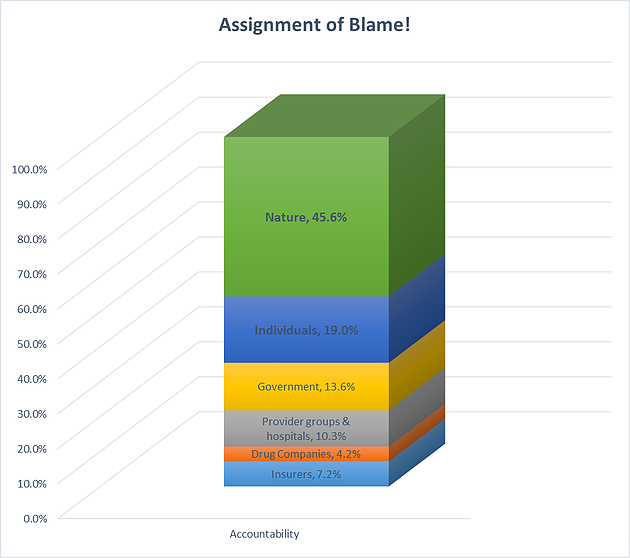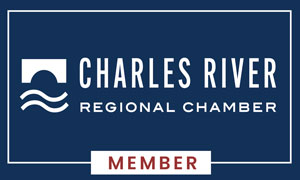Who’s to Blame for the High Cost of Healthcare?
It is quite common for a politician to point fingers at who is to blame for the rising cost of healthcare. In addition, policy holders have to fork over a huge portion of their monthly salary for coverage they may never use. I am not writing to politicize the issue or as a consumer advocate (not that I am against that concept), rather I am trying to identify a method to truly understand the cost of the healthcare to society, identify who really is to blame, and form an opinion on what each can do to stem the rising tide.
Understanding the cost of health care
The cost of healthcare in some respects is straightforward. First, define the services which are health care and then add them up. To get a per capita amount divide by the number covered. This could be on a national basis or for a smaller insured pool (for example, a state Medicaid program or a large employer). In none of these situations have I heard rumblings or grumblings about the cost being too low. This is a pretty boring exercise.
What makes it more interesting? Well, we should look at some of the true economic benefits of health care:
- A life saved by healthcare could save millions of dollars:
- Life insurance avoids a payment
- Earning potential of that individual (this could be an extra cost to Social Security or Medicare)
- Social ills may be avoided (think of treating substance abuse)
- Families would stay intact
- A life improved by healthcare could save hundreds of thousands:
- Someone disabled could return to work or an older person could keep working longer
- Economic benefit: The United States’ investment in health care clearly produces jobs and also is a major benefit to the country as we sell healthcare services oversees
These items above are rarely mentioned when we discuss the cost of healthcare. One specific issue to raise – with universal healthcare people should be healthier and more productive to older ages – should we raise the retirement age to 75? Clearly that would save some money but it is not a popular viewpoint.
While I don’t have the answer to the dollar impact of the above 3 items it is clear healthcare has some positive returns that are often not mentioned.
Understanding the cost of health care insurance
Assuming we could reflect the true economic cost of health care, it is still a burdensome cost. So we need to start assigning accountability. For this I built a simple model (attached to the blog) to identify the different components of health care insurance in hopes of lowering costs and assigning blame. My inputs are for demonstration purposes only but based on numbers I have seen over my career (though some estimates may vary).
To start, I wanted to break out some of the key drivers of health care costs:
- Sales Expense – insurance is sold not bought. Agents and brokers receive about 2% to 3% of premium
- Health Insurer Administration – Excluding sales expense health insurers have administrative costs and profits. This includes customer service activities, organizing and managing care, meeting complex government regulatory requirements, and paying fees and taxes to state and local governments.
- Waste – This is the well-publicized waste which if we improved efficiency we could lower costs. Waste in the system could be as high as 15% of claims.
- Public Health – Often publicized (“Obesity Epidemic”, “Opioid Epidemic”, and even “Avian Flu”) but rarely mentioned in the same article with costs of health care. Many diseases are solved by diet and exercise or other personal or public health measures. In this I estimate 30% of care spending could fall off.
- Cost of Services – Some providers are very high cost as they use their reputation or geographic monopoly to demand a higher price, probably doesn’t drive cost more than 5% to 10% however, depending on the locality. However, if these providers are truly higher quality doesn’t that demand a higher reimbursement?
- Cost of Services /Government Cost Shifting – Medicaid typically pays less than cost and Medicare pays close to cost on services, the rest of us make up the difference and this could load insurance costs 10% to 15% or more.
- Cost of Rx – The drug companies – enough said! This represents the cost of drugs over their true cost to manufacture.
- Theoretical Medical & Rx Cost Target – once the above are removed we get to a theoretical cost of care which could be 40% or less of current levels.
Walking through each – here is my distribution:

How to play the blame game?
Now the fun part is how to play the blame game (remember I am not pointing fingers I am building a math formula). This step is fairly simple, let’s take each of the cost drivers above and assign who’s to blame of the key stake holders:
- Insurers
- Drug companies
- Provider groups & hospitals
- Government
- Individuals
- Nature
Building the Blame Matrix. For this exercise we simply take each cost component and estimate how much of that component is a given stakeholders responsibility. My thoughts:


What is some of the rationale? Well, sales expense is partially due to insurers not having direct sales methods plus individuals using the path of least resistance. Insurers are responsible for administrative costs but much of that cost is set by the government through regulation and much of the services are demanded by their customers (individuals). Waste is on close to everyone but providers perform the services and individuals request them. Governments drive waste by limiting insurers’ ability to manage costs and drug companies advertise in hopes of creating more demand. Public health is another near universal blame as insurers are late to the game in managing health, providers typically only treat disease, governments invest in care not prevention, and let’s face it individuals are unhealthy (I place some of that blame on nature). High cost providers are due to individuals desiring access to that provider and providers demanding their high payment. Insurers have been slow to tie the actual cost of services to the individuals so I blame them as well. Government cost shifting is all on the government – they could pay the fair cost for government programs, thus lessening the burden on the paying customers (though in fairness many of us would complain about the taxes). Drug costs are partially due to drug companies but there is a tendency of individuals to demand certain high cost drugs in lieu of a lower cost alternative. The rest is on nature and/or God depending on your personal beliefs.






